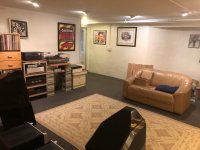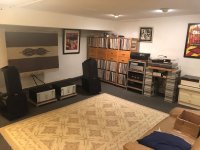I am building an audio stand for my system, four levels, culminating with a turntable at the top. I am building the stand out of 1.5" pine and metal piping for a solid rigid design and industrial look.
Any suggestions on feet for this stand? If possible height adjustable would be nice as the floors in my 100+ year old house aren't perfectly level.
Thanks!
Any suggestions on feet for this stand? If possible height adjustable would be nice as the floors in my 100+ year old house aren't perfectly level.
Thanks!
ChrisM91:
I own a Maplenoll Apollo turntable, which weighs just over 200 lbs. For many years, my turntable stand was comprised of cinder blocks and wood shelving and sat on a concrete floor. Ugly (think college cheap) but absolutely stable. Looking to improve the room's cosmetics, I built a new turntable stand using extruded aluminum struts; three levels, nice maple shelving. Looks great but wobbles just a little, enough to ruin my turntable's otherwise perfect balance. I can't seem to eliminate the wobble. Aggravating as hell.
My new plan is to modify the stand's design to replace the rear two legs with a single leg. Tripods are infinitely more stable than four-legged designs. Your experience may well be vastly different than mine, but I though my situation was worth mentioning.
Good luck with your build.
Regards,
Scott
I own a Maplenoll Apollo turntable, which weighs just over 200 lbs. For many years, my turntable stand was comprised of cinder blocks and wood shelving and sat on a concrete floor. Ugly (think college cheap) but absolutely stable. Looking to improve the room's cosmetics, I built a new turntable stand using extruded aluminum struts; three levels, nice maple shelving. Looks great but wobbles just a little, enough to ruin my turntable's otherwise perfect balance. I can't seem to eliminate the wobble. Aggravating as hell.
My new plan is to modify the stand's design to replace the rear two legs with a single leg. Tripods are infinitely more stable than four-legged designs. Your experience may well be vastly different than mine, but I though my situation was worth mentioning.
Good luck with your build.
Regards,
Scott
Hello,
I am about to finish a DIY turntable still waiting for Sota in the USA to send me a made to measure pulley.
My turntable is not that heavy i think around 120 pounds.
Some turntables do care a lot about the thing they stand upon. Usually something heavy gives better results.
The French people who '' surrounded '' the designer of the Verdier turntable have done some serious testing about this subject.
Dry sand and lead or leadshot seem to work well.
Of you use very sturdy metal pipes in a kind of oil platform construction and you '' introduce '' a vibration into one of these pipes it will probably be transferred upwards without much of '' energy loss'''
This is similar to using sand in between two panels in a loudspeaker cabinet . If you use to thick sturdy panels they will not vibrate in a way that will allow the sand to do its job. So they used two thinner panels with some small wooden blocks in between them. Most of the vibration would be absorbed by the sand.
Before starting to make the motor housing ( pom material with several tubular holes, different diameter and in vertical and horizontal direction to be filled with leadshot ( maybe also add oil like Teres did in the past) I contacted a technician and he told me to stop the vibration going from one side to the other side of the housing i would need to add irregularities so it would act like a kind of labyrinth.
If you picture an oil platform again you will see it need a lot to be changed into a construction that would not be afraid of a storm because a lot of weight is like up in the air. So for an audiorack i would make the center of gravity as low as possible. Usually the area close to the ground will not be used to position gear. So this could be a nice area to add weight by means of sand/leadshot.
Once i made a thin complete welded sandbox that i filled with sand for my cd transport.
When being empty it sounds like a bell but once filled it is perfect. USA being a country with leadshot all around it could be easy to do.
Having a tripod ( 4 feet is for a chair tripod is for camera and turntable) with 3 feet wide apart and the weight kind of in the middle it will be ok.
Greetings, eduard
I am about to finish a DIY turntable still waiting for Sota in the USA to send me a made to measure pulley.
My turntable is not that heavy i think around 120 pounds.
Some turntables do care a lot about the thing they stand upon. Usually something heavy gives better results.
The French people who '' surrounded '' the designer of the Verdier turntable have done some serious testing about this subject.
Dry sand and lead or leadshot seem to work well.
Of you use very sturdy metal pipes in a kind of oil platform construction and you '' introduce '' a vibration into one of these pipes it will probably be transferred upwards without much of '' energy loss'''
This is similar to using sand in between two panels in a loudspeaker cabinet . If you use to thick sturdy panels they will not vibrate in a way that will allow the sand to do its job. So they used two thinner panels with some small wooden blocks in between them. Most of the vibration would be absorbed by the sand.
Before starting to make the motor housing ( pom material with several tubular holes, different diameter and in vertical and horizontal direction to be filled with leadshot ( maybe also add oil like Teres did in the past) I contacted a technician and he told me to stop the vibration going from one side to the other side of the housing i would need to add irregularities so it would act like a kind of labyrinth.
If you picture an oil platform again you will see it need a lot to be changed into a construction that would not be afraid of a storm because a lot of weight is like up in the air. So for an audiorack i would make the center of gravity as low as possible. Usually the area close to the ground will not be used to position gear. So this could be a nice area to add weight by means of sand/leadshot.
Once i made a thin complete welded sandbox that i filled with sand for my cd transport.
When being empty it sounds like a bell but once filled it is perfect. USA being a country with leadshot all around it could be easy to do.
Having a tripod ( 4 feet is for a chair tripod is for camera and turntable) with 3 feet wide apart and the weight kind of in the middle it will be ok.
Greetings, eduard
Thanks for the replies
My Systemdek IIX turntable sits on an isolation boxI built. The isolation box is a piece of wood with racquet balls cut in half, on top of it is a "sandbox". The sandbox is a exactly what it sounds like, a 4 inch deep box full of sand that my turntable then sits atop of.
Further research does reveal that three legs is better than four so I will go that route. In terms of the legs themselves is there any preference? Type, make, etc?
My Systemdek IIX turntable sits on an isolation boxI built. The isolation box is a piece of wood with racquet balls cut in half, on top of it is a "sandbox". The sandbox is a exactly what it sounds like, a 4 inch deep box full of sand that my turntable then sits atop of.
Further research does reveal that three legs is better than four so I will go that route. In terms of the legs themselves is there any preference? Type, make, etc?
ChrisM91:
I can only speak for myself; I have no expertise other than from personal experience. I built an equipment rack using Bosch Rexroth extruded aluminum struts about 10 years ago; the struts are available in multiple sizes and designs, are used extensively in industrial applications and are also used by many of the commercial manufacturers of audio equipment stands. They are strong, versatile and attractive. The line also includes a variety of connectors, feet and other requisite parts. I got a good deal at the time, but Bosch's products are on the expensive side. Competitors have crept into the market and the struts are now generically referred to as "T-slots." I have since built amp stands and the turntable stands using competing products from 8020, which is priced below Bosch. You can also find extruded aluminum struts and connectors on AliExpress at an additional savings (though I have no idea as to the quality).
Add some shelves and the results can be quite attractive. The photos are of my basement music room before it was renovated (note the cinder block turntable stand). While my speakers, preamplifier and phono amp have all been upgraded, I have no plans to touch the equipment rack.
Good luck, whichever direction you go.
Regards,
Scott
I can only speak for myself; I have no expertise other than from personal experience. I built an equipment rack using Bosch Rexroth extruded aluminum struts about 10 years ago; the struts are available in multiple sizes and designs, are used extensively in industrial applications and are also used by many of the commercial manufacturers of audio equipment stands. They are strong, versatile and attractive. The line also includes a variety of connectors, feet and other requisite parts. I got a good deal at the time, but Bosch's products are on the expensive side. Competitors have crept into the market and the struts are now generically referred to as "T-slots." I have since built amp stands and the turntable stands using competing products from 8020, which is priced below Bosch. You can also find extruded aluminum struts and connectors on AliExpress at an additional savings (though I have no idea as to the quality).
Add some shelves and the results can be quite attractive. The photos are of my basement music room before it was renovated (note the cinder block turntable stand). While my speakers, preamplifier and phono amp have all been upgraded, I have no plans to touch the equipment rack.
Good luck, whichever direction you go.
Regards,
Scott
Attachments
Last edited:
- Status
- This old topic is closed. If you want to reopen this topic, contact a moderator using the "Report Post" button.

